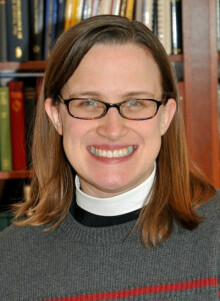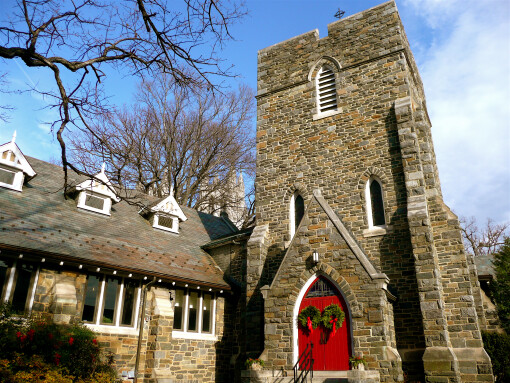Here, There and Everywhere

Series: Easter
Speaker: The Rev'd Emily Griffin
So where is Jesus now? Every week it rolls off our tongues in the Creed, like we know what we’re saying: “He ascended into heaven and is seated at the right hand of the Father. He will come again in glory…” Does that mean he’s absent now? If all we’re doing here is paying respects to a fallen hero and holding onto other people’s 2000 year-old memories while the world rages on around us, then I’m not sure what good we’re doing. On this weekend in particular, as we remember all who have died serving their country, as we mourn for terrorism’s latest victims young and old, as we grieve our own losses closer to home, it’s tempting to think of Jesus as just one more person we love but see no longer – that honoring his memory is the best we can do. We’re here, and he’s there – wherever “there” may be.
We can blame part of our confusion on today’s reading from Acts, an event known in church circles as the Ascension. While all of the Gospels report an empty tomb on Easter morning, and three have Christ making appearances to his followers – only Luke (the author of Acts as well) tells us why they stop seeing him. Matthew and John end with Jesus still on the scene. I understand why. It’s like why I always draw people wearing shoes. I don’t know how to draw feet. Likewise, it’s easier to end the “good news” with Jesus still visibly on stage than to write an exit. In Acts, we learn that the appearances lasted for about 40 days – and then they stopped. Luke tries to account for that, as well as to give Jesus’ followers a way to talk about how they still experienced him sight unseen. Whenever they felt the strength and power of God – even when they were suffering (maybe especially then), they somehow felt Jesus with them.
So Luke presents what Harvey Cox in his book When Jesus Came to Harvard calls “the vertical solution.” We’re told that Jesus was lifted up and that a cloud took him out of their sight. And frankly that worked for Luke’s original audience – who thought in terms of a three-tiered universe: the underworld – or realm of the dead, the heavens – where God lives above, and the earth in the middle where we live. It doesn’t work so well for us though, who now thanks to science have a different vision of the universe. I mean, is heaven really up? We haven’t found the ends of the universe yet as we know it. Where then does space end and heaven begin? You can see the difficulty in taking the imagery too literally.
We know we’re dealing with poetic language, at least on some level. Think about where we say Jesus went next – “the right hand of God.” Do we really think God has hands as we do? The ancient writers used this phrase to talk about Jesus’ relationship to the God he called “Father.” Back then and still in some cultures, the right hand was the hand of power. To be a ruler’s right hand man was to have access to that power, the ability to speak and act in his name. So for the earliest Christians, to imagine Jesus, the crucified One, now at the right hand of God, was to picture him vindicated and victorious. It helped them to remember that death was not and never will be the end of the story.
But if Jesus is at God’s right hand, does that mean he’s no longer with us? Well, I suppose that depends on where we think God is – or where we believe heaven to be. If we trust that God remains present in creation and isn’t some dotty old watchmaker gazing off into the distance, if heaven isn’t so much a place as another dimension of reality, then Jesus can’t be far away. To think of it this way is not to be heretical or dismissive of heaven or our tradition. As Martin Luther once put it, “the right hand of God is everywhere.”
We have to admit that words can’t capture these realities. It’s not just that we weren’t there 2000 years ago as eyewitnesses; we don’t have words to speak adequately about what happens after we die, much less what happened to a risen Christ. We have no choice but to talk in metaphor. It’s a way to keep us humble in our claims. Again, I point to Luther, who said, “as little as children know in their mother’s womb about their birth, so little do we know about life everlasting.” When it comes to life beyond death – be it Jesus’ or ours – we’re like children who haven’t been born yet.
If we think of heaven above and earth beneath as figures of speech – as ways of talking about the fullness of the presence of God (i.e. heaven) vs. the world we know most days where we see as through a mirror dimly (i.e. earth) – and not as a scientific description of reality, we can more fully understand what the Ascension might mean. In Luke’s view, Christ opened the path to heaven in the Ascension – to the full awareness of God’s presence, and so that he might be with us in all places and in all times.
So what of all this talk of Jesus “coming again” then? Personally, I like how Harvey Cox talks about it. He points out that that the Greek word parousia – from which we get the notion of a second coming in the Bible – can also be translated as “appearing.” He thinks “second coming” is a little misleading, because it presupposes some kind of absence. Cox prefers appearing because, in his words, “it suggests the presence – perhaps someday in a new and fuller way – of one who has been here all along.” We might experience Jesus’ appearing as a return, but only because his presence is so often unrecognized. That doesn’t mean he’s not already here.
How is he with us then if we can’t see him? Protestants emphasize that Jesus is with us in the Word as it’s read and faithfully preached. Catholics tend to emphasize the sacraments. As Episcopalians who try at least to welcome truth in all camps, we say he’s in both. He’s with us not just when we hear about him, but as we share the bread and wine as well. What happens on the altar is important, sure, but more important is what happens when we receive it – when it becomes part of us. In St. Augustine’s words, we become what we receive in Communion – we become the body of Christ given for the life of the world.
It’s frightening to think that people seeking Jesus look to us, his followers, for guidance – and that they have every right to expect a resemblance. Trust me – I’m not equating the Church with Christ; we do so many things that are not in the least bit Christ-like. But we are encouraged to look for Christ in and among each other. Or to state it even more boldly, as we do in the Baptismal Covenant, we’re to seek and serve Christ in all persons, whether they’ve ever darkened the doors of a church or not. In Matthew 25, we’re told that whenever we serve the least of these – whenever we feed the hungry or welcome the stranger or care for the sick or visit the prisoner – we’re seeking and serving him.
It’s hard to believe that we can find Christ in the midst of suffering, but sometimes that’s when he feels closest. Whenever we’re feeling the brokenness of humanity, whether it’s the ravages of cancer or the nightly news - the Creator might feel distant, the Spirit vague and ineffable. It’s Jesus who knew the limits of a human body, who lived sacrificial love and justice and felt the weight of it all. It was Jesus my Grandma reached for as she was dying; it was his face she couldn’t wait to see. That’s part of what our reading from 1st Peter is trying to get at, I think. For some of us anyway, the toughest part of suffering is the isolation we feel as a result. No one knows exactly what it’s like inside our skin, that’s true; the problem is that the pain or loss we feel can expand in our vision until it’s all we see.
The author here reminds us that we’re not alone in our suffering, and not just because others suffer too – but because Jesus is still with us now. There are things we can do while we wait for that presence to fully appear, of course. We can walk in humility and not claim to know more than we do. We can cast all our anxiety on him instead of sharing it so liberally with everyone else we know. We can practice self-discipline and try resisting both retaliation and despair. We can follow Jesus’ example and respond with compassion to the suffering around us. And as Acts reminds us, we can say yes and receive the power of the Spirit when it’s offered and trust that it’s coming even when we don’t sense it yet. We can witness to the healing and power we’ve already experienced in this life and trust that more is on the way.
It’s good to know there are things we can do as the world rages on around us. But ultimately, the good news isn’t about what we can or should do; it’s about what God has already promised in Christ to do in and through us. We don’t make Jesus present by remembering him; we don’t keep him or anyone else alive with our thoughts and prayers. He’s already here – and there – on the road we’re traveling now and on the journeys we can’t even imagine yet. He’s with us as we grieve and as we resist, honoring the particularity and beauty of every life, and pointing the way through each and every death to new life. To the One who can be known here and there and everywhere in between – Amen.
 Welcome to St. Alban’s Church! Every Sunday, and most days in between, people gather in this place to worship, to learn, to grow, to share the joys and struggles of our lives, and to seek God’s grace in the midst of our lives. We do not come because we have it all figured out, but because we are seeking light on the way. We come as we are and welcome one another.
Welcome to St. Alban’s Church! Every Sunday, and most days in between, people gather in this place to worship, to learn, to grow, to share the joys and struggles of our lives, and to seek God’s grace in the midst of our lives. We do not come because we have it all figured out, but because we are seeking light on the way. We come as we are and welcome one another.

